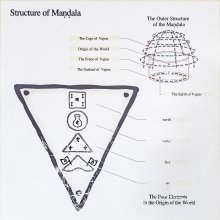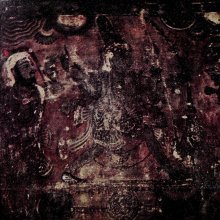Sumeru, Su-meru: 29 definitions
Introduction:
Sumeru means something in Buddhism, Pali, Hinduism, Sanskrit, Jainism, Prakrit, the history of ancient India, Marathi, Hindi, Tamil. If you want to know the exact meaning, history, etymology or English translation of this term then check out the descriptions on this page. Add your comment or reference to a book if you want to contribute to this summary article.
Images (photo gallery)
In Hinduism
Purana and Itihasa (epic history)
Source: archive.org: Puranic EncyclopediaSumeru (सुमेरु).—See under Mahāmeru.
Source: archive.org: Shiva Purana - English TranslationSumeru (सुमेरु) is another name for Meru: a mountain mentioned in the Śivapurāṇa 2.2.9. Accordingly as Kāma related to Brahmā:—“[...] Even as I entered the zone, the living beings fell into my power but lord Śiva and his Gaṇas were not moved at all. O Brahmā, when Śiva went to the Himālayan ridge, Rati, Spring and I reached the place. Wherever He went whether on Meru (or Sumeru) Nāgakeśara or Kailāsa, I too went there immediately”.
According to the Śivapurāṇa 2.2.22, as Śiva said to Sitā:—“[...] O gentle lady, the clouds usually come only upto the foot of Kailāsa. They never go above it. The clouds never go above the mountain Sumeru. The clouds Puṣkara, Āvartaka etc. reach the foot of Jambu (and return)”.
Source: Cologne Digital Sanskrit Dictionaries: The Purana IndexSumeru (सुमेरु).—Is Meru (s.v.).*
- * Brahmāṇḍa-purāṇa II. 14. 49; 15. 42.

The Purana (पुराण, purāṇas) refers to Sanskrit literature preserving ancient India’s vast cultural history, including historical legends, religious ceremonies, various arts and sciences. The eighteen mahapuranas total over 400,000 shlokas (metrical couplets) and date to at least several centuries BCE.
Shaktism (Shakta philosophy)
Source: Wisdom Library: Śrīmad Devī BhāgavatamSumeru (सुमेरु) is the name of a tree found in maṇidvīpa (Śakti’s abode), according to the Devī-bhāgavata-purāṇa 12.10. Accordingly, these trees always bear flowers, fruits and new leaves, and the sweet fragrance of their scent is spread across all the quarters in this place. The trees (e.g. Sumeru) attract bees and birds of various species and rivers are seen flowing through their forests carrying many juicy liquids. Maṇidvīpa is defined as the home of Devī, built according to her will. It is compared with Sarvaloka, as it is superior to all other lokas.
The Devī-bhāgavata-purāṇa, or Śrīmad-devī-bhāgavatam, is categorised as a Mahāpurāṇa, a type of Sanskrit literature containing cultural information on ancient India, religious/spiritual prescriptions and a range of topics concerning the various arts and sciences. The whole text is composed of 18,000 metrical verses, possibly originating from before the 6th century.

Shakta (शाक्त, śākta) or Shaktism (śāktism) represents a tradition of Hinduism where the Goddess (Devi) is revered and worshipped. Shakta literature includes a range of scriptures, including various Agamas and Tantras, although its roots may be traced back to the Vedas.
Kavya (poetry)
Source: Wisdom Library: KathāsaritsāgaraSumeru (सुमेरु) is the name of a Vidyādhara according to the Kathāsaritsāgara, chapter 45. Accordingly, as the Asura Maya said in the assembly hall of king Candraprabha and Sūryaprabha: “... send out ambassadors, and collect your subordinate kings, and your friends and connections; then we will unite with Sumeru, prince of the Vidyādharas, and we will conquer Śrutaśarman, and win the sovereignty of the sky-goers. And Sumeru is our ally, considering us as friends, for he received at the outset a command from Śiva to support Sūryaprabha and give him his own daughter”.
The story of Sumeru was narrated by the Vidyādhara king Vajraprabha to prince Naravāhanadatta in order to relate how “Sūryaprabha, being a man, obtain of old time the sovereignty over the Vidyādharas”.
The Kathāsaritsāgara (‘ocean of streams of story’), mentioning Sumeru, is a famous Sanskrit epic story revolving around prince Naravāhanadatta and his quest to become the emperor of the vidyādharas (celestial beings). The work is said to have been an adaptation of Guṇāḍhya’s Bṛhatkathā consisting of 100,000 verses, which in turn is part of a larger work containing 700,000 verses.
Source: Shodhganga: A critical appreciation of soddhalas udayasundarikathaSumeru (सुमेरु).—One of the mountains of Jambūdvīpa.—Sumeru has received a fabulous treatment at the hands of ancient Indian writers. Kālidāsa and Soḍḍhala call it a mountain of gold and make it the dwelling place of supernatural beings like Vidyādharas and Kiṃpuruṣas. Soḍḍhala has referred to one Vipula; but according to Āpte, it is a name of the mountain Meru. According to Rājaśekhara the Meru mountain is situated in the middle of the Jambūdvīpa. It is encircled by Ilāvartavarṣa.

Kavya (काव्य, kavya) refers to Sanskrit poetry, a popular ancient Indian tradition of literature. There have been many Sanskrit poets over the ages, hailing from ancient India and beyond. This topic includes mahakavya, or ‘epic poetry’ and natya, or ‘dramatic poetry’.
Vaishnavism (Vaishava dharma)
Source: Pure Bhakti: Bhagavad-gita (4th edition)Sumeru (सुमेरु) refers to “the golden mountain on which the Ganges waters fall”. (cf. Glossary page from Śrīmad-Bhagavad-Gītā).

Vaishnava (वैष्णव, vaiṣṇava) or vaishnavism (vaiṣṇavism) represents a tradition of Hinduism worshipping Vishnu as the supreme Lord. Similar to the Shaktism and Shaivism traditions, Vaishnavism also developed as an individual movement, famous for its exposition of the dashavatara (‘ten avatars of Vishnu’).
In Buddhism
Tibetan Buddhism (Vajrayana or tantric Buddhism)
Source: Wisdomlib Libary: VajrayoginiSumeru (सुमेरु) is the name of a mountain associated with Caṇḍogra: the eastern cremation ground (śmaśāna) according to the Vajravārāhī-sādhana by Umāpatideva as found in te 12th century Guhyasamayasādhanamālā. As a part of this sādhana, the practicioner is to visualize a suitable dwelling place for the goddess inside the circle of protection which takes the form of eight cremation grounds.

Tibetan Buddhism includes schools such as Nyingma, Kadampa, Kagyu and Gelug. Their primary canon of literature is divided in two broad categories: The Kangyur, which consists of Buddha’s words, and the Tengyur, which includes commentaries from various sources. Esotericism and tantra techniques (vajrayāna) are collected indepently.
Mahayana (major branch of Buddhism)
Source: Wisdom Library: Maha Prajnaparamita SastraSumeru (सुमेरु).—According to the Mahāprajñāpāramitāśāstra (chapter XIV), mount Sumeru has a height of 84,000 yojanas; at its summit is the city of the Trāyastriṃṣas. Beside Mount Meru is a mountain called Yugandhara, 42,000 yojanas high; it has four peaks on each of which is a city inhabited by a group of Caturmahārājikas. The lands of the other gods, Yāmas, etc., made of seven jewels (saptaratnamaya), are situated in space (ākāśa) where they are supported by wind and so on up to the Pure Abodes (śudddhavāsa).
According to the 2nd century Mahāprajñāpāramitāśāstra (chapter XV).—“Mount Sumeru is situated at the center of the four continents; the sun makes a circuit around Sumeru and successively lights up the four continents (dvīpaka)”.
Source: academia.edu: A Study and Translation of the GaganagañjaparipṛcchāSumeru (सुमेरु) is the name of a mountain, according to the Gaganagañjaparipṛcchā: the eighth chapter of the Mahāsaṃnipāta (a collection of Mahāyāna Buddhist Sūtras).—Accordingly, “[...] Save for those who were sitting in the pavilion in the sky, the rest of them in the great three-thousand of worlds, staying on the surface of the earth, as far as its foundations, thought that they disappeared. The king of the mountain (parvatarāja), Mount Sumeru, Mount Cakravāḍa, and Mount Mahācakravāḍa disappeared from the sight of living beings. Villages, towns, market-towns, royal cities, capitals disappeared as well. However, with the lion’s throne (simhāsana) of the Lord it was another matter, they perceived it as shining ten thousand yojanas high as placed in these pavilions placed in the vault of the sky”.

Mahayana (महायान, mahāyāna) is a major branch of Buddhism focusing on the path of a Bodhisattva (spiritual aspirants/ enlightened beings). Extant literature is vast and primarely composed in the Sanskrit language. There are many sūtras of which some of the earliest are the various Prajñāpāramitā sūtras.
General definition (in Buddhism)
Source: Wisdom Library: Dharma-samgrahaSumeru (सुमेरु) refers to the “excellent mountain” and represents one of the “eight mountains” (parvata) as defined in the Dharma-saṃgraha (section 125). The Dharma-samgraha (Dharmasangraha) is an extensive glossary of Buddhist technical terms in Sanskrit (e.g., sumeru). The work is attributed to Nagarjuna who lived around the 2nd century A.D.
Source: Wisdom Library: BuddhismSumeru:—(Also known as Mount Sumeru) According to Indian mythology, Mount Sumeru stands at the center of the world.
Source: Buddhist Door: GlossarySanskrit words. It means wonderful high mountain. It is composed of gold. silver, lapis lazuli and crystal, therefore it is so wonderful. It is eighty four thousand Yugamdhara high and eighty found thousand Yugamdhara wide, which is the greatest mountain amongst all.In Jainism
General definition (in Jainism)
Source: archive.org: TrisastisalakapurusacaritraSumeru (सुमेरु) or Meru is the name of a mountain situated in the interior of Jambūdvīpa in the “middle world” (madhyaloka), according to chapter 2.2 [ajitanātha-caritra] of Hemacandra’s 11th century Triṣaṣṭiśalākāpuruṣacaritra: an ancient Sanskrit epic poem narrating the history and legends of sixty-three illustrious persons in Jainism.
Accordingly:—“in the Middle World (i.e., madhyaloka) there are countless continents and oceans, with auspicious names Jambūdvīpa, Lavaṇa, etc.; [...] In the interior of Jambūdvīpa Meru, golden, round like a sthāla, is buried 1,000 yojanas in the ground at its base, is 99,000 yojanas high, and 10,000 yojanas in diameter at the surface of the earth. At the top it is 1,000 yojanas in diameter. It is in three parts, and its body is divided by the three worlds. Now, the first part of Sumeru, composed of pure earth, stone, diamond, and gravel is 1,000 yojanas high. The second is 63,000 yojanas high, its ground composed of gold, crystal, aṅka, and silver. The third part is 36,000 yojanas and is composed of slabs of gold. Its gleaming peak is made of cat’s eye. Its height is 40 yojanas, its diameter at the base is 12 yojanas, 8 at the middle and 4 at the top. [...]”.
Source: Encyclopedia of Jainism: Tattvartha Sutra 3: The Lower and middle worldsSumeru (सुमेरु) or Sudarśana is a mountain in the centre of Jambūdvīpa: the tree enveloping the continent of Jambūdvīpa: the first continent of the Madhya-loka (middle-word), according to the 2nd-century Tattvārthasūtra 3.10.—The height of Sumeru Mount is 100040 yojana. Sumeru Mount has three regions in the form of terraces. The first terrace is 500 yojana from earth. The second region is 62500 yojana above the first terrace. The third terrace is 36000 yojana above the second terrace.
There are four forests (vana) on Sumeru Mount. They are called Bhadraśāla, Nandanavana, Saumanasavana and Pāṃdukavana. The first forest lies at the foot of the mountain and the rest in its platform. How many Jina temples are there in the four forests? There are four Jina temples in four directions in each forest for a total of 16 temples on the mount.

Jainism is an Indian religion of Dharma whose doctrine revolves around harmlessness (ahimsa) towards every living being. The two major branches (Digambara and Svetambara) of Jainism stimulate self-control (or, shramana, ‘self-reliance’) and spiritual development through a path of peace for the soul to progess to the ultimate goal.
India history and geography
Source: archive.org: Geography in Ancient Indian inscriptionsSumeru (सुमेरु).—In the Mandsaur inscription of the Guild of the Silk-weavers, the mountains Sumeru and Kailāsa are described as the large breasts of earth. Another Mandsaur inscription refers to the rocks of the glens of the Sumeru being split open by the blows of the horns of the bull of the God Śūlapāṇi.
Source: archive.org: Personal and geographical names in the Gupta inscriptionsSumeru (सुमेरु) is the name of a mountain mentioned in the Gupta inscription No. 17 and 32. The Gupta empire (r. 3rd-century CE), founded by Śrī Gupta, covered much of ancient India and embraced the Dharmic religions such as Hinduism, Buddhism and Jainism. In No. 17 the mountain Sumeru is described as one of the breasts of the earth (the other being Kailāśa) and the Gupta king Kumāragupta is mentioned as the lord of the earth. In No. 32 it has been named as Amarabhūdhara.
Sumeru is identified with Rudra Himālaya in Garhwal, where the river Gaṅgā has its source, it is near Badarikāśrama. Its other names are Meru, Karṇikācala, Ratnasānu, Svargiri, Svargigiri and Kāñcanagiri.

The history of India traces the identification of countries, villages, towns and other regions of India, as well as mythology, zoology, royal dynasties, rulers, tribes, local festivities and traditions and regional languages. Ancient India enjoyed religious freedom and encourages the path of Dharma, a concept common to Buddhism, Hinduism, and Jainism.
Languages of India and abroad
Marathi-English dictionary
Source: DDSA: The Molesworth Marathi and English Dictionarysumēru (सुमेरु).—m (S) The sacred mountain Meru. See mēru.
Marathi is an Indo-European language having over 70 million native speakers people in (predominantly) Maharashtra India. Marathi, like many other Indo-Aryan languages, evolved from early forms of Prakrit, which itself is a subset of Sanskrit, one of the most ancient languages of the world.
Sanskrit dictionary
Source: DDSA: The practical Sanskrit-English dictionarySumeru (सुमेरु).—
1) the sacred mountain Meru, q. v.
2) Name of Śiva.
Derivable forms: sumeruḥ (सुमेरुः).
Sumeru is a Sanskrit compound consisting of the terms su and meru (मेरु).
Source: Cologne Digital Sanskrit Dictionaries: Edgerton Buddhist Hybrid Sanskrit DictionarySumeru (सुमेरु).—(compare Sumeruvatsa), name of a nāga king: Mahā-Māyūrī 246.23. As name of a mountain (Pali id., oftener Sineru; also Meru), commoner than, but as in Sanskrit not distinguish- able from, Meru (contrary to [Boehtlingk and Roth]'s statement); see Kirfel, [Kosmographie der Inder] 15*, 16*, 182; it is located at the middle of the world (as in Sanskrit), and surrounded by seven concentric rings of mountain ranges, Yugaṃdhara etc. (Kirfel, op. cit. 186).
Source: Cologne Digital Sanskrit Dictionaries: Shabda-Sagara Sanskrit-English DictionarySumeru (सुमेरु).—mfn. (-ruḥ-ruḥ-ru) Best, excellent. m.
(-ruḥ) 1. The sacred mountain Meru: see meru. 2. Siva. E. su excellent, mi to shed or scatter, (radiance,) ru aff.
Source: Cologne Digital Sanskrit Dictionaries: Benfey Sanskrit-English DictionarySumeru (सुमेरु).—I. m. = Meru. Ii. adj. excellent.
Sumeru is a Sanskrit compound consisting of the terms su and meru (मेरु).
Source: Cologne Digital Sanskrit Dictionaries: Cappeller Sanskrit-English DictionarySumeru (सुमेरु).—[masculine] [Name] of a mountain.
Source: Cologne Digital Sanskrit Dictionaries: Monier-Williams Sanskrit-English Dictionary1) Sumeru (सुमेरु):—[=su-meru] [from su > su-ma] m. Name of a mountain (= meru q.v.), [Rāmāyaṇa; Kālidāsa; Buddhist literature] (cf. [Monier-Williams’ Buddhism 120])
2) [v.s. ...] Name of a Vidyā-dhara, [Kathāsaritsāgara]
3) [v.s. ...] of Śiva, [Horace H. Wilson]
4) [v.s. ...] mfn. very exalted, excellent, [ib.]
Source: Cologne Digital Sanskrit Dictionaries: Yates Sanskrit-English DictionarySumeru (सुमेरु):—[su-meru] (ruḥ) 2. m. The sacred mountain Meru; Shiva. a. Best, excellent.
Source: DDSA: Paia-sadda-mahannavo; a comprehensive Prakrit Hindi dictionary (S)Sumeru (सुमेरु) in the Sanskrit language is related to the Prakrit word: Sumeru.
[Sanskrit to German]
Sanskrit, also spelled संस्कृतम् (saṃskṛtam), is an ancient language of India commonly seen as the grandmother of the Indo-European language family (even English!). Closely allied with Prakrit and Pali, Sanskrit is more exhaustive in both grammar and terms and has the most extensive collection of literature in the world, greatly surpassing its sister-languages Greek and Latin.
Hindi dictionary
Source: DDSA: A practical Hindi-English dictionarySumeru (सुमेरु):—(nm) the mythological mountain of gold.
...
Prakrit-English dictionary
Source: DDSA: Paia-sadda-mahannavo; a comprehensive Prakrit Hindi dictionarySumeru (सुमेरु) in the Prakrit language is related to the Sanskrit word: Sumeru.
Prakrit is an ancient language closely associated with both Pali and Sanskrit. Jain literature is often composed in this language or sub-dialects, such as the Agamas and their commentaries which are written in Ardhamagadhi and Maharashtri Prakrit. The earliest extant texts can be dated to as early as the 4th century BCE although core portions might be older.
Tamil dictionary
Source: DDSA: University of Madras: Tamil LexiconSumēru (ஸுமேரு) noun < Sumēru. A peak in Mt. Mēru. See சுமேரு. [sumeru.]
Tamil is an ancient language of India from the Dravidian family spoken by roughly 250 million people mainly in southern India and Sri Lanka.
See also (Relevant definitions)
Partial matches: Meru, Cu, Shu.
Starts with: Cumeru, Sumeru Worlds, Sumerudhvaja, Sumerudhvajayatanashantanetrashri, Sumeruja, Sumerukalpa, Sumerupushpa, Sumerushiri, Sumerushri, Sumeruvatsa.
Ends with: Cumeru, Gunasumeru, Lakshanasumeru, Manisumeru, Punyasumeru, Shirisumeru, Shrisumeru.
Full-text (+246): Svargiri, Bhusvarga, Amaradri, Kanakacala, Tridashalaya, Kancanagiri, Meru, Saumeruka, Sumeruja, Karnikacala, Saumerava, Svargigiri, Sumeruvatsa, Hemanga, Svargagiri, Hemagiri, Hemadri, Panduka, Melanduka, Cumeru.
Relevant text
Search found 78 books and stories containing Sumeru, Sumēru, Su-meru, Sumaeru; (plurals include: Sumerus, Sumērus, merus, Sumaerus). You can also click to the full overview containing English textual excerpts. Below are direct links for the most relevant articles:
Garga Samhita (English) (by Danavir Goswami)
Verse 6.14.31 < [Chapter 14 - The Glories of Ratnākara, Raivata, and Kācala]
Verses 6.14.19-20 < [Chapter 14 - The Glories of Ratnākara, Raivata, and Kācala]
Verse 6.14.23 < [Chapter 14 - The Glories of Ratnākara, Raivata, and Kācala]
Maha Prajnaparamita Sastra (by Gelongma Karma Migme Chödrön)
Part 5 - Casting the mount sumerus far away < [Chapter XLIX - The Four Conditions]
Act 1.6: Definition of trisāhasramahāsāhasralokadhātu < [Chapter XIV - Emission of rays]
Part 10 - Attaining the qualities of all the Buddhas < [Chapter XLIX - The Four Conditions]
Brihad Bhagavatamrita (commentary) (by Śrī Śrīmad Bhaktivedānta Nārāyana Gosvāmī Mahārāja)
Verse 1.4.74 < [Chapter 4 - Bhakta (the devotee)]
Verse 1.6.24 < [Chapter 6 - Priyatama (the most beloved devotees)]
Verse 1.7.156 < [Chapter 7 - Pūrṇa (pinnacle of excellent devotees)]
Guhyagarbha Tantra (with Commentary) (by Gyurme Dorje)
Text 21.3 (Commentary) < [Chapter 21 (Text And Commentary)]
Chapter 21 - Eulogy to the Wrathful Deities < [Chapter 21 (Text And Commentary)]
Text 15.5 (Commentary) < [Chapter 15 (Text and Commentary)]
Related products






